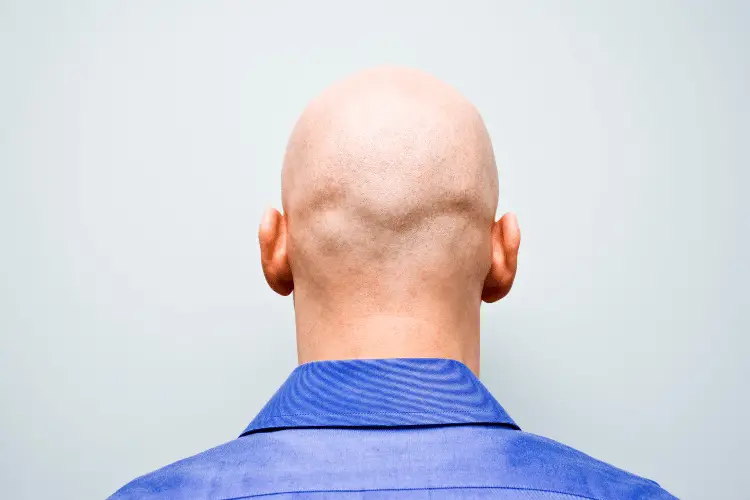The official description of testosterone is usually something like “the primary male hormone in the human body”, and while that is true, testosterone is much, much more than that.
In fact, since its discovery, new scientific studies link testosterone levels with countless aspects of our bodies.
If you’re interested in finding out more about testosterone, you’ve come to the right place. In this guide, I’ll walk you through 17 exciting and fun facts about testosterone.
1. In Males It’s Produced in the Testicles, But the Journey Starts in the Brain
The testicles are responsible for the production of many hormones. However, testosterone remains the most significant (and talked about) hormone.
Besides testicles, testosterone is also made indirectly by the adrenal glands, which are two small glands located on top of each kidney.
These glands produce other steroid hormones that enzymes can convert into testosterone, such as aldosterone and cortisol.
However, the amount of testosterone produced using this method is much lower than that produced in the testicles.
The secretion of testosterone into the bloodstream is mainly controlled by the brain, specifically the hypothalamus.
The hypothalamus sends a signal to the pituitary gland in the brain, which releases another hormone that travels to the testicles (via the blood) and stimulates them to produce and release testosterone.
2. Testosterone Differentiates a Fetus into a Male During Pregnancy
The production of testosterone in males starts as early as the 7th week of embryonic development in humans.
During that time, the Y chromosome in males produces the hormone, which stimulates the fetus to develop male sex organs.
Studies also show that the production of testosterone during that time stops cyclical patterns in males.
This is actually one of the reasons why men don’t experience monthly reproductive cycles and have relatively stable testosterone levels throughout the month.

Additionally, a 2009 study of the effect of fetal testosterone shows that it has a remarkable impact on the typical behaviors of boys and girls during childhood.
3. It’s Responsible for Male Secondary Features During Puberty
As previously established, testosterone has many functions and plays a significant role in primary sex development. This includes aspects like:
- Development of male sex organs (penis and testes), and their enlargement
- Testicular descent, which usually happens by the 33rd gestational week
- Production of sperm, also known as “spermatogenesis”
However, these are not the only functions that testosterone directly affects. During puberty (usually between the age of 11 to 14 years old), both Follicle Stimulating Hormone (FSH) and testosterone play a significant role in developing secondary sex characteristics.
These traits include:
- The growth of facial and body hair
- Lower-pitched voice and the development of Adam’s apple in the throat
- Further development of the male genitalia
- Enlargement of testes and prostate gland
- Structural development, such as broader chests and increased muscle mass (more about that in the following sections)
4. Women Produce Testosterone Too
Although testosterone is classified as an androgen (the collective term that describes male sex hormones), it’s actually secreted in both men and women!
This happens because male and female sex hormones both originate from the same source (precursor), called “pregnenolone”.
As a result, during the production of estrogen and progesterone by the ovaries as well as the adrenal glands, testosterone is also produced.
However, the main difference is that it’s produced at a much lower rate than in males. According to studies, the average adult female bloodstream testosterone should be around 15 to 70 nanograms per deciliter (ng/dL).
On the other hand, an average adult male can have over 15 to 20 times more testosterone in his blood than a woman of the same age.
Despite that, the small amount of testosterone produced in females is crucial for their health, as they’re responsible for functions like:
- The development of healthy reproductive organs
- Maintaining cardiovascular health (as testosterone controls
- Retaining healthy bone mass, muscle development, and energy levels
Surprisingly, before puberty, both males and females have around the same concentration of testosterone, which is less than 12 ng/dL (between the age of 1 to 5 years old) and less than 25 ng/dL (between the age of 5 to 10 years old).
5. Testosterone Isn’t Exclusive to Humans
Besides male and female humans, almost all mammals and most vertebrates produce testosterone as well.
According to studies, the chemical structure of testosterone is almost identical across all species.
However, the main effect of the hormone varies from one animal to another depending on its concentration and how it’s metabolized in the body.
Like humans, testosterone is more prominent in male animals than females. Not only that, but it’s also responsible (whether directly or indirectly) for some of the main identifying features, such as:
- Differences in size
- Unique coloration and patterns
- Development of unique structures or body parts, such as horns
6. Its Official Discovery Was in the 20th Century, But Its Concept Dates Back Much Earlier
Testosterone was first discovered during the early 20th century. In fact, 3 European scientists from different countries announced the isolation of the compound in 1935, although each of them was working independently!
The term “testosterone” was coined by Ernst Laqueur because he isolated the hormone from a bull’s testes.
Despite that, humans were aware of the idea of testosterone for centuries. In other words, the concept of a special substance turns a young boy into a man and controls his virility and vigor.
For instance, many civilizations associated the testicles (where testosterone is produced) with masculinity.
This is because farmers noticed the changes that male animals go through upon castration (increased body fat, reduced aggression, etc.).
In fact, according to a report by Reuters, Ancient Roman Olympic athletes used to eat raw bovine testicles, believing it would give them an energy boost before games!
7. It Affects Bone Density and Muscle Mass
Besides being a primary male sex hormone, testosterone is also an anabolic hormone, which stands for its “body-building” features.
Testosterone is widely established as a primary factor in the biosynthesis of proteins in the body.
Not only that, but it also inhibits the breakdown of proteins, which is a process known as “catabolism”.
The hormone doesn’t only increase the size of the muscle, but it also increases its ability to contract and overcome fatigue, which results in stronger muscles.
Since testosterone promotes muscle growth (hypertrophy), many bodybuilders supplement it through external injection to increase their muscle mass.

However, using hormone injections without medical supervision can lead to serious health problems.
Besides muscles, testosterone also affects the mass and density of our bones, especially for men.
In fact, since testosterone levels drop as men grow older, older men’s bones become brittle and prone to fractures more easily.
8. Testosterone Levels Can Fluctuate Within a Normal Range
Testosterone exists in many bodily fluids, which is why we can test for its concentration in our bodies through various methods, including urine, saliva, and male semen.
The most common method to test for testosterone concentration is through blood sampling and, ideally, the average concentration of serum testosterone in a healthy male ranges between 300 to 1,000 ng/dL.
However, the exact concentration of the hormone in your body may vary greatly depending on the time of the day.
According to a report by the New York Times, testosterone levels peak at around 8 A.M. and reach their lowest levels at 8 P.M. For that reason, some athletes prefer working out in the early morning to maximize their gains.
Besides sex, the average serum testosterone concentration varies depending on many factors, such as genetics, age, nutrition, athletic status, and more.
9. It Affects Sexual Desire in Both Sexes
As a sex hormone, testosterone has a remarkable impact on libido and sexual desire among both males and females.
Studies show that individuals on the higher end of the healthy testosterone range have a higher sex drive than those on the lower end.
In fact, a 2018 study shows that using testosterone injection to normalize its concentration in men with lower testosterone levels improves their sex drive and reduces the symptoms associated with hypogonadism, such as erectile dysfunction.
With that being said, you should know that testosterone isn’t the only factor that can affect these aspects, and some men could have perfect testosterone levels and still suffer from sexual disorders.
10. Testosterone Is Associated with Baldness
We’ve previously mentioned that testosterone is responsible for facial and body hair growth, but do you know that it is also deeply associated with male pattern baldness (also known as male androgenic alopecia)?
Well, technically speaking, baldness is not caused by testosterone itself, but by its metabolite, which is known as Dihydrotestosterone or DHT.
This chemical is created when an enzyme (called 5-alpha reductase) binds to testosterone. DHT then accumulates in hair follicles, which causes them to fall off.
Luckily, there are some treatments that can help with male pattern baldness. The most popular ones are:
- Minoxidil (Rogaine): A topical non-prescription treatment applied directly to the scalp
- Finasteride (Propecia): an oral prescription treatment that works by inhibiting the 5-alpha reductase enzyme, preventing the formation of DHT.

11. Testosterone Can Affect Your Mood and Mental Health
The impact of testosterone on males is not only physiological, but psychological as well! In fact, many studies established that men with relatively higher testosterone tend to be more aggressive than those with lower levels.
This mainly happens because the male hormone is also responsible for stimulating some subcortical areas in the brain, which are responsible for aggressive behaviors while serotonin and cortisol inhibit them.
Besides aggression, testosterone is associated with lower anxiety levels among both men and women.
According to another research, testosterone was found to positively reduce symptoms of anxiety, unconscious fear, and depression among study subjects.
However, the higher level of testosterone in the previous study was still within the healthy range. In fact, some limited studies associated abnormally high testosterone levels with symptoms of mania and depression!
12. Female Testosterone Is Higher When She Falls in Love
Many researchers and psychologists tried to understand why relationships are much stronger in the beginning.
While there are plenty of complex psychological factors behind this phenomenon, testosterone level is also one of them.
A recent study was conducted to measure the hormonal changes when women fall in love. Surprisingly, it was found that women’s serum testosterone (along with FSH) gets a noticeable boost at the beginning of a relationship.
Another study performed on men showed that single men and those who have been in a relatively new relationship also have higher concentrations of testosterone.
13. Men with Higher Testosterone Are More Daring
Many studies have established a correlation between higher testosterone and the affinity to take more risks in various aspects of life.
For example, a 2021 study used the Iowa Gambling Task to measure the risk-management and decision-making properties in males.
According to the study, subjects with higher testosterone were more likely to make daring decisions during risk trials.
The association of testosterone with risk-taking wasn’t only limited to games. In another 2018 study, males with relatively higher serum testosterone were more likely to choose risky investments with immediate high returns as opposed to low-risk ones.
However, the effects of testosterone in that regard are different among women. The Human Behavior and Evolution Society conducted an experiment on more than 500 MBA students to establish a relationship between testosterone and risk aversion.
While male participants with higher testosterone had lower risk aversion (in line with the previous studies), females with higher testosterone had a relatively low-risk aversion.
14. Winning Can Boost Male’s Testosterone Levels
There are many factors that can affect testosterone levels in males and females, and surprisingly, winning or even feeling like a winner is among them!
For example, a study on male college students engaging in competition found that winners weren’t only in a better mood, but they also had higher testosterone levels, although their level of cortisol remained the same.
Another study also confirmed these findings and showed that losing a classical competition can even lead to a reduction in testosterone levels.
In fact, even in sports, fans who support a winning team may show an elevated level of testosterone than the fans of the losing team, according to a study by the University of Utah.
One thing you should know here is that succeeding may boost your testosterone level, but higher testosterone levels don’t necessarily increase your odds of success. A major UK study on over 306,000 men and women found that there’s no correlation between the two factors.
15. Excessively High Testosterone Causes Many Health Issues
Having abnormally high testosterone is remarkably rare. In fact, in most cases, excessively high testosterone is caused by two main reasons, which are:
- Doping
- Using anabolic injections to increase muscle mass, especially by bodybuilders
- Tumors in the testicles or adrenal gland
Unfortunately, high testosterone levels are a serious health problem because it’s associated with many symptoms and adverse reactions.
The most bizarre one is that excessively high testosterone levels could cause a notable reduction in sperm count as well as erectile dysfunction and even shrinkage in testicles.
In fact, impotence and lower sperm count are among the most common symptoms of hormone replacement therapy in the case of low testosterone.
In addition to reproductive and cardiovascular side effects, excessively high testosterone can contribute to other problems, such as:
- Liver problems
- Oily skin and the development of acne
- Headaches
- Irritability and unusually aggressive behavior
- Sleep apnea (shortness of breath during sleep)
16. You Can Improve Your Testosterone Levels Naturally
If you want to boost your testosterone level naturally, there are actually a variety of foods that can help you achieve that!
For example, a 2012 study found that consuming ginger for 3 months on a daily basis can increase testosterone production by 17.7% among those suffering from naturally low testosterone.
Another hidden gem when it comes to boosting testosterone naturally is seafood, especially oysters.
Since they’re rich in zinc (an essential component of testosterone) and other minerals, they’re highly associated with a marked increase in serum testosterone levels.
Vegetables and leafy greens are also popular enhancers of testosterone because they’re rich in magnesium, such as kale and spinach. According to a 2011 study, magnesium supplementation can increase testosterone production.
17. Sleep Is Critical for Testosterone Production
Another factor that greatly impacts testosterone levels is the quality and amount of sleep you get at night.
As previously mentioned, serum testosterone varies throughout the day, so it’s impacted by your circadian rhythm.
Additionally, one study shows that sleep deprivation for over one week reduced testosterone concentration remarkably among participants.
Wrap Up
There you have it! A list of 17 of the most fascinating facts about the testosterone hormone and what it can affect.
As you can see, the primary male hormone has an incredible influence on many aspects of humans’ (and especially men’s) lives, whether it’s from a physical or psychological standpoint.
References
- https://www.ncbi.nlm.nih.gov/books/NBK279031/
- https://www.ncbi.nlm.nih.gov/books/NBK556007/
- https://medlineplus.gov/ency/article/002219.htm
- https://www.endocrineweb.com/endocrinology/overview-testes
- https://www.ncbi.nlm.nih.gov/pmc/articles/PMC4785901/
- https://www.ncbi.nlm.nih.gov/pmc/articles/PMC2778233/
- https://www.ncbi.nlm.nih.gov/books/NBK557763/
- https://www.ncbi.nlm.nih.gov/books/NBK10095/
- https://www.msdmanuals.com/home/men-s-health-issues/biology-of-the-male-reproductive-system/puberty-in-boys
- https://academic.oup.com/jcb/article/35/6/789/2547879
- https://www.ncbi.nlm.nih.gov/pmc/articles/PMC3334410/
- https://joe.bioscientifica.com/view/journals/joe/214/2/155.xml
- https://my.clevelandclinic.org/health/articles/22002-androgens
- https://www.usada.org/spirit-of-sport/education/pregnenolone/
- https://www.ncbi.nlm.nih.gov/pmc/articles/PMC6391653/
- https://pubmed.ncbi.nlm.nih.gov/26358173/
- https://eje.bioscientifica.com/view/journals/eje/180/6/EJE-19-0071.xml
- https://www.healthline.com/health/low-testosterone/testosterone-levels-by-age
- https://www.reuters.com/article/us-oly-doping-history-day5-idUSBRE8700YC20120801
- https://pubmed.ncbi.nlm.nih.gov/21058750/
- https://pubmed.ncbi.nlm.nih.gov/2917954/
- https://www.ncbi.nlm.nih.gov/pmc/articles/PMC7867125/
- https://www.ncbi.nlm.nih.gov/pmc/articles/PMC5036835/
- https://www.mountsinai.org/health-library/tests/testosterone
- https://www.nytimes.com/2018/03/27/well/live/testosterone-supplements-low-t-treatment-libido.html
- https://pubmed.ncbi.nlm.nih.gov/22552705/
- https://www.ncbi.nlm.nih.gov/pmc/articles/PMC5649360/
- https://www.ncbi.nlm.nih.gov/books/NBK532933/
- https://www.webmd.com/erectile-dysfunction/erectile-dysfunction
- https://www.health.harvard.edu/blog/a-logical-approach-to-treating-erectile-dysfunction-201211275583
- https://www.ncbi.nlm.nih.gov/books/NBK278957/
- https://www.ncbi.nlm.nih.gov/pmc/articles/PMC6691938/
- https://pubmed.ncbi.nlm.nih.gov/9951956/
- https://journal.psych.ac.cn/adps/EN/10.3724/SP.J.1042.2019.01607
- https://pubmed.ncbi.nlm.nih.gov/31785281/
- https://www.ncbi.nlm.nih.gov/pmc/articles/PMC3693622/
- https://pubmed.ncbi.nlm.nih.gov/24016385/
- https://www.ncbi.nlm.nih.gov/pmc/articles/PMC3946856/
- https://www.ncbi.nlm.nih.gov/pmc/articles/PMC6861983/
- https://pubmed.ncbi.nlm.nih.gov/15177709/
- https://journals.sagepub.com/doi/10.1177/147470491501300116
- https://www.frontiersin.org/articles/10.3389/fnins.2021.631195/full
- https://www.ncbi.nlm.nih.gov/pmc/articles/PMC5964298/
- https://www.ncbi.nlm.nih.gov/pmc/articles/PMC2741240/?tool=pmcentrez
- https://pubmed.ncbi.nlm.nih.gov/1478633/
- https://www.nature.com/articles/s41598-017-12260-3
- https://pubmed.ncbi.nlm.nih.gov/9811365/
- https://www.ncbi.nlm.nih.gov/pmc/articles/PMC8318368/
- https://www.malefertility.com/blog/understanding-the-role-of-testosterone-in-male-fertility
- https://www.medicalnewstoday.com/articles/signs-of-high-testosterone
- https://www.iasj.net/iasj?func=fulltext&aId=71548
- https://www.ncbi.nlm.nih.gov/pmc/articles/PMC6868249/
- https://pubmed.ncbi.nlm.nih.gov/20352370/
- https://www.ncbi.nlm.nih.gov/pmc/articles/PMC2453053/
- https://www.ncbi.nlm.nih.gov/pmc/articles/PMC4445839/



